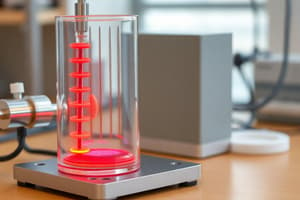Podcast
Questions and Answers
What is the first objective of this experiment?
What is the first objective of this experiment?
- To measure the heat of fusion of ice.
- To measure the specific heat capacity of water. (correct)
- To measure the specific heat capacity of aluminium.
What formula represents the specific heat capacity (c)?
What formula represents the specific heat capacity (c)?
- c = Qm/ΔT
- c = Q/mΔT (correct)
- c = QΔT/m
What does the specific heat capacity of water being 4190 J/kg °C mean?
What does the specific heat capacity of water being 4190 J/kg °C mean?
You need to supply 4190 J of heat to raise the temperature of 1 kg of water by 1°C.
What is the purpose of finding the slope of temperature/time graph according to the text?
What is the purpose of finding the slope of temperature/time graph according to the text?
What should you do if you want to heat the water sample faster during the experiment?
What should you do if you want to heat the water sample faster during the experiment?
The heat of fusion is variable and changes based on the substance and its temperature.
The heat of fusion is variable and changes based on the substance and its temperature.
If Q amount of heat melts m mass of solid, its heat of fusion is Lf = ______
If Q amount of heat melts m mass of solid, its heat of fusion is Lf = ______
What is the law of conservation of energy?
What is the law of conservation of energy?
What does the text describe a thermocouple as?
What does the text describe a thermocouple as?
Write the formula for the electric power through a resistor.
Write the formula for the electric power through a resistor.
Flashcards
Specific Heat Capacity
Specific Heat Capacity
The amount of heat needed to raise the temperature of a unit mass of a substance by one degree.
Heat Transfer
Heat Transfer
Heat transfer process where energy is exchanged due to temperature difference.
Calorimeter
Calorimeter
A device with a small container, used to measure heat transfer in experiments.
Joule (J)
Joule (J)
Signup and view all the flashcards
Heat of Fusion
Heat of Fusion
Signup and view all the flashcards
Law of Conservation of Energy
Law of Conservation of Energy
Signup and view all the flashcards
Electric Power
Electric Power
Signup and view all the flashcards
Thermocouple
Thermocouple
Signup and view all the flashcards
∆T/∆t (Temperature Rate)
∆T/∆t (Temperature Rate)
Signup and view all the flashcards
Voltage (V)
Voltage (V)
Signup and view all the flashcards
Current (I)
Current (I)
Signup and view all the flashcards
Power (P)
Power (P)
Signup and view all the flashcards
Why cool water below room temperature first?
Why cool water below room temperature first?
Signup and view all the flashcards
Why stir the water?
Why stir the water?
Signup and view all the flashcards
Why use an insulated calorimeter?
Why use an insulated calorimeter?
Signup and view all the flashcards
Heat Transfer Equation
Heat Transfer Equation
Signup and view all the flashcards
Principle of Heat Exchange
Principle of Heat Exchange
Signup and view all the flashcards
Why use Melting Ice?
Why use Melting Ice?
Signup and view all the flashcards
Latent Heat of Fusion
Latent Heat of Fusion
Signup and view all the flashcards
Heat Exchange in Ice Experiment
Heat Exchange in Ice Experiment
Signup and view all the flashcards
cw
cw
Signup and view all the flashcards
cal
cal
Signup and view all the flashcards
mw
mw
Signup and view all the flashcards
m
m
Signup and view all the flashcards
Th
Th
Signup and view all the flashcards
TR
TR
Signup and view all the flashcards
T
T
Signup and view all the flashcards
mi
mi
Signup and view all the flashcards
What happens when Water Temp < Room Temp?
What happens when Water Temp < Room Temp?
Signup and view all the flashcards
What happens when Water Temp > Room Temp?
What happens when Water Temp > Room Temp?
Signup and view all the flashcards
Study Notes
- This experiment measures the specific heat capacity of water and aluminum, and the heat of fusion of ice (optional).
Objectives
- Measure the specific heat capacity of water.
- Measure the specific heat capacity of aluminum.
- Measure the heat of fusion of ice (optional).
Measuring the Specific Heat of Water (cw)
- Water is heated through an electric heater to determine the specific heat capacity of water.
- The time rate of change of temperature around room temperature is measured.
- When current I and voltage V are applied to the heater, the water's temperature rises by ΔT in time Δt.
- The energy conservation equation, assuming a perfectly isolated system and negligible heat absorption by the water container, is IVΔt = mwcwΔT.
cwrepresents the specific heat of water.- The equation can be rewritten as ΔT = (VI / mwcw)Δt, where the temperature rises linearly with time.
- Specific heat of water is calculated by finding the slope of the T vs. t curve.
Procedure for Measuring the Specific Heat of Water
- Measure the mass of the aluminum calorimeter (smaller container) and fill it about 50% with water.
- Mix ice into the water and stir until the temperature drops at least 10°C below room temperature.
- Ensure the final water volume does not exceed 70% of the calorimeter's total volume.
- Find the mass of the water in the calorimeter (mw).
- Place the plastic cover and cap assembly on the calorimeter.
- Insert the thermometer through the hole in the cap, ensuring it does not touch the electric heater.
- Connect the thermocouple to the computer through an adapter and interface.
- Ensure the power supply is switched off and all dials are at the lowest position (counter-clockwise).
- Connect the electric heater with electric leads to the power supply, ensuring the heating filament is inside the water.
- Open Data Studio, run the program, and obtain a temperature-time graph.
- Turn on the heater by turning on the power supply.
- Raise the value of current (I) and voltage (V) gradually to supply moderate power (P=IxV), around 5 to 7 Watts, for a slow temperature rise.
- Keep stirring the water continuously for even heat distribution, especially between 2°C below and 2°C above room temperature.
- Stop stirring when the temperature reaches 2°C above room temperature, but continue heating until 60°C for the second part of the experiment.
- Find the slope of the temperature/time graph very close to room temperature.
- Calculate the specific heat capacity of the water using equation (1).
- Compare the result with the standard value of 4190 J/kg°C.
Finding Specific Heat of Aluminum (cal)
- Continue heating the water until the temperature exceeds 60°C, then add more than 50g of aluminum shots to find the aluminum's specific heat.
- When mass m of aluminum shots at room temperature TR is added to mass mw of hot water at temperature TH, the mixture reaches a final temperature T.
- Assuming a perfectly isolated system, the heat gained by the aluminum shots equals the heat lost by the water; the conservation of energy equation is mwcw(Th - T) = mc(T – TR).
- The specific heat of aluminum is then c = mwcw(Th-T) / m(T-TR).
Procedure for Finding Specific Heat of Aluminum
- Continue heating the water from the previous part of the experiment.
- Stir the water continuously for at least 1 to 2 minutes.
- Measure the mass of some aluminum shots (between 50 to 100 g) and ensure they will not displace water out of the calorimeter.
- To heat water faster, the power can be raised up to 20 Watts, but the voltage should not exceed 6V.
- Once the temperature reaches around 60°C, reduce the heating rate to around 10 Watts and stir.
- When the temperature reaches around 65°C, turn off the power supply and disconnect the cables from the calorimeter cap assembly.
- Gently add the aluminum shots, ensuring no pieces escape or cause water to splash.
- Put the cap assembly back immediately and stir the water.
- Find the water's temperature just before adding aluminum shots (Th) and the mixture's temperature (T) from the graph.
- Measure the mass of the container and its contents to find the mass of the water (mw).
- Calculate the value of “c” using equation (2).
- Compare it with the given value of specific heat of aluminum (910 J/kg°C) at room temperature.
- If needed, include the heat lost by the aluminum container for a more accurate result.
Finding Heat of Fusion of Ice (Lf) (Optional)
- The latent heat of fusion of ice is found by adding melting ice to tap water and conserving the heat energy of the system.
- If mi amount of melting ice is added to mw amount of water at Tw °C, the conservation of energy equation is miLf + micw(T – 0) + mwcw(T – Tw) = 0.
- The latent heat of fusion is Lf = (mwcw(Tw-T) / mi ) - cWT.
Procedure for Finding the Latent Heat of Fusion of Ice
- Fill 2/3 of the foam calorimeter with room temperature water and measure the mass of the water (mw).
- Keep the electric heater cables disconnected from the power supply.
- Connect the thermocouple to the computer as in exercise 1.
- Run the temperature-time graph in Data Studio.
- Slowly add melting ice into the water and stir until it gets melted.
- The temperature graph will decrease; keep stirring until the temperature stabilizes (straight line for about 2 minutes).
- Once all the ice is melted, the temperature will stabilized (T).
- Measure the mass of the calorimeter and its contents.
- Measure the mass of the ice (mi) by subtracting mass of the room temperature water from the final mass of the calorimeter and its contents.
- Calculate the latent heat of fusion of ice.
- Compare it with the standard value.
Appendix 1: Specific Heat Capacity
- Specific heat is the amount of heat required to change a unit mass of a substance by one degree in temperature.
- Q is the amount of heat to raise the temperature by ΔT of an object with mass m with specific heat capacity c, then c=Q/mΔT.
- Specific heat capacity of water is 4190 J/kg °C, meaning 4190 J of heat is needed to raise the temperature of 1 kg of water by 1°C.
Heat of Fusion
- Heat of fusion is the amount of heat required to convert a unit mass of solid into liquid without a temperature change.
- If Q amount of heat melts a mass m of a solid: Lf = Q/m
- The process of fusion occurs at a constant temperature (0 °C for ice melting to water).
- The heat of fusion of ice is 333 kJ/kg.
The Law of Conservation of Energy
- It says the total energy of an isolated system remains constant. Energy can only be transferred from one body to another.
Electric Power
- The power (P) through the resistor (electric heater) is P = IV.
- I is the current and V is the voltage.
- The heat energy (Q) generated by the electric power in time t is Q = IVΔt.
Thermocouple Info
- A thermocouple is a device used to measure temperature; it's an electrical thermometer.
Appendix 2
- It's very important to take the slope very close to the room temperature. There will always be some heat exchange between the environment and the system. Therefore when the temperature of system (water) is less than the room temperature it will gain some extra heat from atmosphere. Rate of temperature raise will be faster than normal. In such a situation the specific heat is underestimated. On the other hand when the temperature of the system (water) is more than the room temperature there will be leakage of heat to the atmosphere and hence the rate of temperature raise will be slower. In this case the specific heat is overestimated. Right around room temperature the rate of rise of temperature will completely due to the electric heater because there will be negligible heat exchange between surrounding and the system. Therefore it is appropriate to consider the slope around the room temperature only.
Appendix 3
- Find the heat supplied by the heater for a specific temperature interval (ex: 15-20°C).
- Find the heat gained by the water for the interval.
- Find the heat gained by the aluminum container for this interval.
- Find the rate of heat exchange between the system and surrounding for this interval.
- Compare the rate of heat exchange with TR±1°C.
- Repeat those steps for another interval of higher temperature (ex: from 55-60°C).
- Compare the rate of heat exchange for this interval with other two previous intervals.
- Come to a conclusion.
Studying That Suits You
Use AI to generate personalized quizzes and flashcards to suit your learning preferences.




